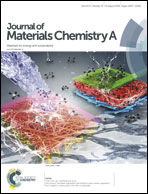Monolayer-like hybrid halide perovskite films prepared by additive engineering without antisolvents for solar cells†
Abstract
Searching for a simple method to replace the conventional antisolvent process with the objective of achieving a high-quality perovskite film is indispensable for the practical manufacture of solar cells. In this work, we explored antisolvent-free additive engineering to fabricate compact CH3NH3PbI3 (MAPbI3) perovskite films combining the coordination effect of methylammonium chloride (MACl) and methylammonium acetate (MAAc). The MACl coordination with organic and metal halides in the precursor solution resulted in the perovskite film having a large grain size and a single crystal-like cross-section profile (monolayer-like). The introduction of MAAc into the precursor solution reduced the perovskite film shrinkage after the film deposition, presumably due to an increased nucleation rate. Consequently, we succeeded in fabricating high-quality monolayer-like perovskite films with a micro-scale grain size (∼2 μm), a smooth surface and enhanced crystallinity. The time-resolved photoluminescence (PL) spectra and space-charge limited current (SCLC) measurements have confirmed that there was a significantly reduced density of trap states, which has an imminent impact on the perovskite film quality. As a result, the power conversion efficiency (PCE) of the perovskite solar cells (PSCs) using the mixed additive increases to 19.64%, which is much larger than those of devices using a single MACl additive (15.61%). Accordingly, this work provides a new one-step fabrication method of high-quality perovskite films for the coming generation of PSCs.



 Please wait while we load your content...
Please wait while we load your content...